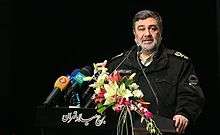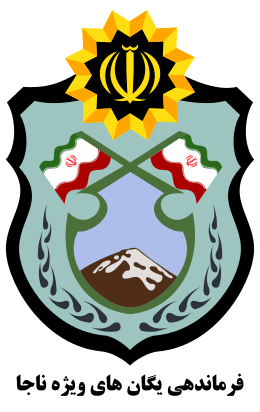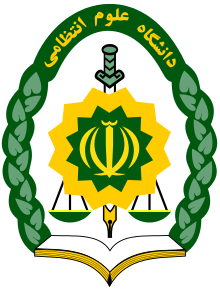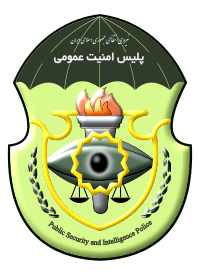Law Enforcement Force of Islamic Republic of Iran
| Law Enforcement Force of Islamic Republic of Iran نیروی انتظامی جمهوری اسلامی ایران Nīrū-ye entezāmī-ye jomhūrī-ye eslāmī-ye Īrān | |||||
|---|---|---|---|---|---|
| Common name | Iranian Police | ||||
| Abbreviation | NAJA | ||||
|
Logo of the Law Enforcement Force of Islamic Republic of Iran | |||||
|
The Official Flag of Iranian Police | |||||
| Motto |
Arabic: كُونُواْ قَوَّامِينَ لِلّهِ شُهَدَاء بِالْقِسْط "Be Persistently Standing Firm for Allah, Witnesses in Justice." [Quran 5:8] | ||||
| Agency overview | |||||
| Formed | 1 April, 1991 | ||||
| Preceding agency |
Shahrbani (1913–1991) Gendarmerie (1910–1991) Committee (1979–1991) | ||||
| Employees | ≈500,000 (including conscripts and reserves)[1] | ||||
| Volunteers | ≈35,000 honorary police[2] | ||||
| Legal personality | Governmental: Government agency | ||||
| Jurisdictional structure | |||||
| National agency | Iran | ||||
|
| |||||
| Map of Iran with province borders | |||||
| Size | 1,648,195 km2 | ||||
| Population | 78,192,200 (2013) | ||||
| Constituting instrument | Law Enforcement Force Act 1990 (Persian) | ||||
| General nature | |||||
| Operational structure | |||||
| Minister responsible | Abdolreza Rahmani Fazli, Minister of Interior[4] | ||||
| Agency executive | Brigadier General Hossein Ashtari, Chief Commander[4] | ||||
| Parent agency | General Staff of Armed Forces | ||||
| |||||
| Website | |||||
|
police | |||||
Law Enforcement Force of Islamic Republic of Iran[6][7][8][9][10] or Disciplinary Force of the Islamic Republic of Iran[11][12] (Persian: نیروی انتظامی جمهوری اسلامی ایران), abbreviated as NAJA (Persian: ناجا) is the uniformed police force in Iran. The force was created in early 1992 by merging the Shahrbani (Persian: شهربانی Šahrbānī), Gendarmerie (Persian: ژاندارمری Žāndārmerī) and Islamic Revolutionary Committees (Persian: کمیته Komīte) into a single force. It has more than 60,000 police personnel, including border guard personnel, and is under the control of the Ministry of Interior.[13] In 2003, some 400 women became the first female members of the police force since the 1979 Iranian Revolution[14] but women are not currently recruited.
History
.svg.png)
The Persian Gendarmerie, also called the Government Gendarmerie (ژاندارمری دولتی), was the first modern highway patrol and rural police force in Persia. A paramilitary force, it also played a significant part in politics from its establishment in 1910 during the Qajar dynasty until the advent of the Pahlavi dynasty in 1921. It was active for some time in Pahlavi era. Nazmiyeh (نظمیه) was also a Law Enforcement force in Persia, with police duties inside cities.
.jpg)
Intensely concerned with matters of internal security in the post-1953 environment, Mohammad Reza Pahlavi authorized the development of one of the most extensive systems of law enforcement agencies in the developing world. The Imperial Iranian Gendarmerie (ژاندارمری شاهنشاهی ایران) and the National Police (Shahrbani شهربانی or Nazmiyeh نظمیه) gained in numbers and responsibilities. The secret police organization, SAVAK, gained special notoriety for its excessive zeal in "maintaining" internal security. But as in the regular armed forces, the shah's management style virtually eliminated all coordination among these agencies. He tended to shuffle army personnel back and forth between their ordinary duties and temporary positions in internal security agencies, in order to minimize the possibility of any organized coups against the throne. Added to this list of institutional shortcomings was agencies' all- important public image, cloaked in mystery and fear.

After the 1979 Revolution, the gendarmerie, which was renamed to the Islamic Republic of Iran Gendarmerie (ژاندارمری جمهوری اسلامی ایران), was numbering nearly 74,000 in 1979, was subordinate to the Ministry of Interior. Its law enforcement responsibilities extended to all rural areas and to small towns and villages of fewer than 5,000 inhabitants. The International Institute for Strategic Studies estimated its manpower at 70,000 in 1986. The Gendarmerie was dissolved in 1990 and its personnel were assigned to the INP.
The National Police of Iran operated with approximately 200,000 men in 1979, a figure that has not fluctuated much since. The National Police was also under the Ministry of Interior, and its responsibilities included all cities with more than 5,000 in population, at least 20 percent of the population. Additionally the National Police was responsible for passport and immigration procedures, issuance and control of citizens' identification cards, driver and vehicle licensing and registration, and railroad and airport policing. Some of these duties were absorbed into the Ministry of the Pasdaran during the early years of the Revolution, and cooperation between these two branches seemed extensive.
Since 1979, both these paramilitary organizations have undergone complete reorganizations. IRP leaders quickly appointed Gendarmerie and police officers loyal to the Revolution to revive and reorganize the two bodies under the Islamic Republic. Between 1979 and 1983, no fewer than seven officers were given top National Police portfolios. Colonel Khalil Samimi, appointed in 1983 by the influential Ali Akbar Nategh-Nouri, then Minister of Interior, who was credited with reorganizing the National Police according to the IRP's Islamic guidelines. The Gendarmerie followed a similar path. Seven appointments were made between 1979 and 1986, leading to a full reorganization. In addition to Brigadier General Ahmad Mohagheghi, the commander in the early republican period who was executed in late summer of 1980 and five colonels were purged. Colonel Ali Kuchekzadeh played a major role in reorganizing and strengthening the Gendarmerie after its near collapse in the early revolutionary period. The commander in 1987, Colonel Mohammad Sohrabi, had served in that position since February 1985 and was the first top officer to have risen from the ranks.
As of 1987, the National Police and the Gendarmerie reflected the ideology of the state. Despite their valuable internal security operations, the roles of both bodies were restricted by the rising influence of the Sepah and the Basij. The Gendarmerie was disbanded in 1991, along with the National Police and Islamic Revolution Committees; all these organizations were merged into the present-day Law Enforcement Force.
The Police–110 unit specializes in rapid-response activities in urban areas and dispersing gatherings deemed dangerous to public order. In 2003, some 400 women became the first female members of the police force since the 1978–79 Revolution.[15]
The current commander is IRGC-born Brigadier General Hossein Ashtari, former first deputy chief of police under Esmail Ahmadi Moqaddam; he relieved his predecessor and was appointed by the Supreme Leader Ayatollah Ali Khamenei on March 9, 2015, on the proposal of the Interior Minister of Iran .[16]
Provincial Security Council

The Provincial Security Council is the highest provincial security body and is made up of the justice administration chief as well as the provincial police chief; it has the task to manage matters pertaining to security.[17] The Council has a provincial jurisdiction charged of managing police issues, ranging from public security issues[18][19][20] to handling of serious criminal cases.[21]
Top organization
All issues related to the Law Enforcement Force within the framework of the law are entrusted with the Interior Ministry; but in the areas of war, the authority lies with the Deputy Chief Commander of the Joint Forces.[22]
police top officers are appointed by the Supreme Leader on the basis of the proposal of the Interior Minister of Iran, but the police force are under the Ministry of the Interior and the Secretary of the Interior is deputy commander in chief of the armed forces for Police Affairs. Law Enforcement Force also consists of several different provincial deputies. Provincial commanders rank between Colonel[23] and Brigadier General,[24] while provincial branch heads rank Colonel.[25]
Branches
The Police-110 unit specializes in rapid-response activities in urban areas and dispersing gatherings deemed dangerous to public order. Marine police have 100 inshore patrol and 50 harbor boats.
The Law Enforcement Force of Islamic Republic of Iran have a number of branches, each with specialized duties:
- The Prevention Police of NAJA (Persian: پلیس پیشگیری ناجا), established in 2005;
- The Intelligence and Public Security Police of NAJA(PAVA for short: Persian پلیس اطلاعات و امنیت عمومی ناجا);
- The Traffic Police of NAJA (Rahvar for short; Persian: پلیس راهنمایی و رانندگی ناجا), established in 1991;
- The Cyber Police of NAJA (FATA for short: Persian پلیس فضای تولید و تبادل اطلاعات ناجا, established in 2011, is Iran's Law Enforcement Force Cyber unit;
- The Anti-Narcotics Police of NAJA (Persian: پلیس مبارزه با مواد مخدر ناجا), is an Anti-Narcotic unit;
- The Immigration & Passport Police of NAJA (Persian: پلیس مهاجرت و گذرنامه ناجا) deals with issues of immigration and issuing passports to Iranian citizens;
- The Diplomatic Police of NAJA (Persian: پلیس دیپلماتیک ناجا);
- The Criminal Investigation Police of NAJA (Persian: پلیس اگاهی ناجا), established in 1991;
- The Border Guard Command of NAJA (Persian: فرماندهی مرزبانی ناجا), established in 2000, is the Iran's border guard organization and its chief is Brigadier General Qasem Rezaee;[26]
- The Special Unit; it was involved in quelling of 2009 Iranian presidential election protests. It is responsible for suppressing riots, anti-terrorist activities, urban defence and rescuing hostages. NAJA special units includes Anti-Terror Special Force("NOPO" for short). According to a former commander, the Special Unit alone has 60,000 members across the country.[27][28]
- The Centre for Strategic Studies of the Iranian Law Enforcement Force, directed by Brigadier General Ahmad Reza Radan.[29]
Branch seals
 Anti-Narcotics Police
Anti-Narcotics Police Criminal Investigation Police
Criminal Investigation Police Prevention Police
Prevention Police Traffic Police
Traffic Police Special Unit
Special Unit.svg.png) Cyber police
Cyber police Border Police
Border Police University of the Law Enforcement Force
University of the Law Enforcement Force Public Security Police
Public Security Police
Chiefs of Law Enforcement Force
Since 1991m the Law Enforcement Force have had six commanders. In brackets it is shown the service of origin:
- Brig. Gen. (Gendarmerie) Mohmmad Sohrabi
- Brig. Gen. (IRGC) Reza Seifollahi: 1992 - 1996
- Brig. Gen. (IRGC) Hedayat Lotfian: 1996 - 2000
- Brig. Gen. (IRGC) Mohammad Bagher Ghalibaf: 2000 - 2005
- Brig. Gen. (IRGC) Ali Abdollahi: 2005 (caretaker)
- Brig. Gen. (IRGC) Esmail Ahmadi Moghadam: 2005 - 2015
- Brig. Gen. (IRGC) Hossein Ashtari: 2015 - present
Equipment
Weapons
- Heckler & Koch MP5
- SIG Sauer P220
- SIG Sauer P226
- Heckler & Koch HK21
- Smith & Wesson Model 10 cal. 38
- Dragunov
- Electroshock weapon
- AK-47
- Uzi
- FIM-92 Stinger
- Remington 870
- PK machine gun
- M79 grenade launcher
- DShK
Cars
- Citroën Xantia
- Samand
- Mercedes-Benz C 240
- Mercedes-Benz E 240
- Renault Mégane
- Mitsubishi Pajero Second generation
- Nissan Xterra N50
- Toyota Land Cruiser 100 Series
- Toyota Hilux Sixth generation and Seventh generation
- Volkswagen Transporter
- Peugeot 207
- Nissan Teana
- Suzuki Grand Vitara
- Formerly used cars
Motorcycles
Aircraft
- Dassault Falcon 20
- HESA IrAn-140
- Aero Commander 690
- Bell 205
- Bell 206
- Bell 212
- Bell 214
- Mil Mi-17
- Cessna 206
- Dorna D-139 Blue Bird
- Cessna 185
See also
- Crime in Iran
- Iranian Cyber Police
- Islamic Republic of Iran Border Guard Command
- Law Enforcement Force of Islamic Republic of Iran rank insignia
Notes
-
 This article incorporates public domain material from the Library of Congress Country Studies website http://lcweb2.loc.gov/frd/cs/.
This article incorporates public domain material from the Library of Congress Country Studies website http://lcweb2.loc.gov/frd/cs/.
References
- ↑ فعالیت ٥٠٠هزار نفر از پرسنل نيروي انتظامي برای تامین امنيت ايام نوروز. Mehr News Agency (in Persian). Retrieved 10 March 2015.
- ↑ اعضای سطح اول پلیس افتخاری مجوز حمل سلاح دریافت میکنند. ANA News Agency (in Persian). Retrieved 10 March 2015.
- ↑ Iran's main intellice agency is Ministry of Intelligence, however, Intelligence and Public Security Police of NAJA is part of Iran Intelligence Community.
- 1 2 "Leader appoints Ashtari as new police chief". Tehran Times. Retrieved 10 March 2015.
- ↑ روز نیروی انتظامی (in Persian). Retrieved 10 March 2015.
- ↑ "UNICEF Iran (Islamic Republic of) - Media centre - Statement by Paul Hulshoff, UNICEF Iran Representative at the opening session of the Seminar on "Police and Justice for Children"". Retrieved 21 July 2015.
- ↑ "Department of Treasury and State Announce Sanctions of Iranian Security Forces for Human Rights Abuses". U.S. Department of State. Retrieved 21 July 2015.
- ↑ "The World Factbook". Retrieved 21 July 2015.
- ↑ "Police Chief stresses law enforcement forces' good conditions".
- ↑ "Photos: Photos: Iranian Police Forces". Retrieved 21 July 2015.
- ↑ Judicial Reform and Reorganization in 20th Century Iran. Books.google.co.uk. Retrieved 22 October 2014.
- ↑ "Supreme Leader's Remarks on the Day of Disciplinary Forces". English.irib.ir. Retrieved 22 October 2014.
- ↑ http://www.csis.org/media/csis/pubs/060728_gulf_iran.pdf
- ↑ Text used in this cited section originally came from: Iran (March 2006) profile from the Library of Congress Country Studies project.
- ↑ "COUNTRY PROFILE: IRAN" (PDF). Lcweb2.loc.gov. May 2008. Retrieved 22 October 2014.
- ↑ "Ayatollah Khamenei appoints Iran new police chief". PressTV. IA. 9 March 2015. Retrieved 8 April 2015.
- ↑ "Tehran officials raise against public flogging". Payvand Iran News. 8 August 2001. Retrieved 21 April 2015.
- ↑ "Film community rallies for Afghan immigrants". Radio Zamaneh. 1 May 2012. Retrieved 21 April 2015.
- ↑ "Iran Report: June 16, 2003". Radio Free Europe. 16 June 2003. Retrieved 21 April 2015.
- ↑ "IRAN: ANNUAL SURVEY OF VIOLATIONS OF TRADE UNION RIGHTS (2005)". tavaana.org. Retrieved 21 April 2015.
- ↑ "3 Tourists Kidnapped in Iran Are Released". Los Angeles Times. 29 December 2003. Retrieved 21 April 2015.
- ↑ Fulfilling Promises: A Human Rights Roadmap for Iran’s New President (PDF). International Campaign for Human Rights in Iran. 2013. p. 31. Retrieved 19 April 2015.
- ↑ "18 terrorists in southern Iran say they get money for operations". Islamic Republic News Agency. 14 January 2015. Retrieved 20 April 2015.
- ↑ "Commander Underlines Full Security at Iran's Eastern Borders". Farsanews. 26 October 2014. Retrieved 20 April 2015.
- ↑ "IRAN - Iranian provincial police arrest over 30 drug groups in spring". WikiLeaks. 11 March 2003. Retrieved 21 April 2015.
- ↑ Niayesh, Umid (27 October 2014). "Iran, Iraq discuss cooperation on border security". Trend. Retrieved 17 April 2015.
- ↑ "Iranian police commander concedes mistakes in 2009 protests". al-Monitor. 2 September 2014. Retrieved 7 April 2015.
- ↑ "Iran police showcase latest anti-riot capabilities". Ashraq al-Awast. 10 October 2014. Retrieved 8 April 2015.
- ↑ "Iran, Iraq to Boost Police Cooperation in Near Future: Police Official". Tasnim News Agency. 18 January 2015. Retrieved 20 April 2015.
External links
| Wikimedia Commons has media related to Police of Iran. |

